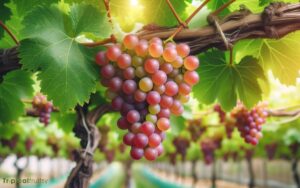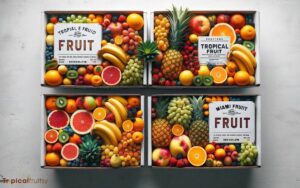What Tropical Fruit Has a Big Seed in the Middle? Explore!
The avocado is a tropical fruit known for its large seed situated in the middle. Other tropical fruits with big seeds include mango, which has a fibrous stone, and jackfruit, with its numerous sizeable seeds.
Tropical fruits are often recognized for their juicy flesh and exotic flavors, but many also have a prominent seed or multiple seeds at their center.
These seeds are crucial for the propagation of the plant species and can vary in size, shape, and edibility.
For instance:
Discover the intriguing world of tropical fruits, each with a seed that holds the secret to new life.
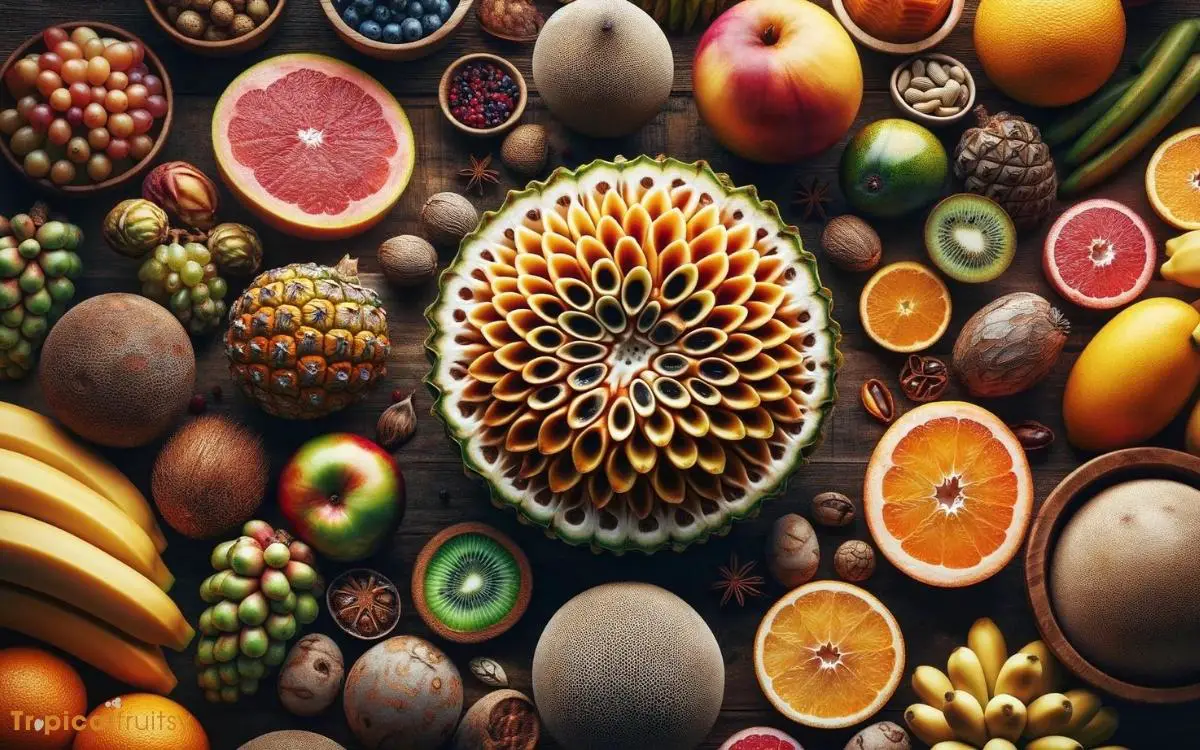
Key Takeaway
Tropical Fruit Seeds: Descriptions and Edibility
| Fruit Name | Seed Description | Edible Part | Seed Edibility |
|---|---|---|---|
| Avocado | One large, round seed | Flesh | Seed is not typically eaten |
| Mango | Single, large, fibrous stone | Flesh | Seed is not edible but the kernel inside is sometimes used |
| Jackfruit | Numerous large, oval seeds | Flesh and seeds | Seeds are edible when cooked |
The Avocado’s Hefty Core
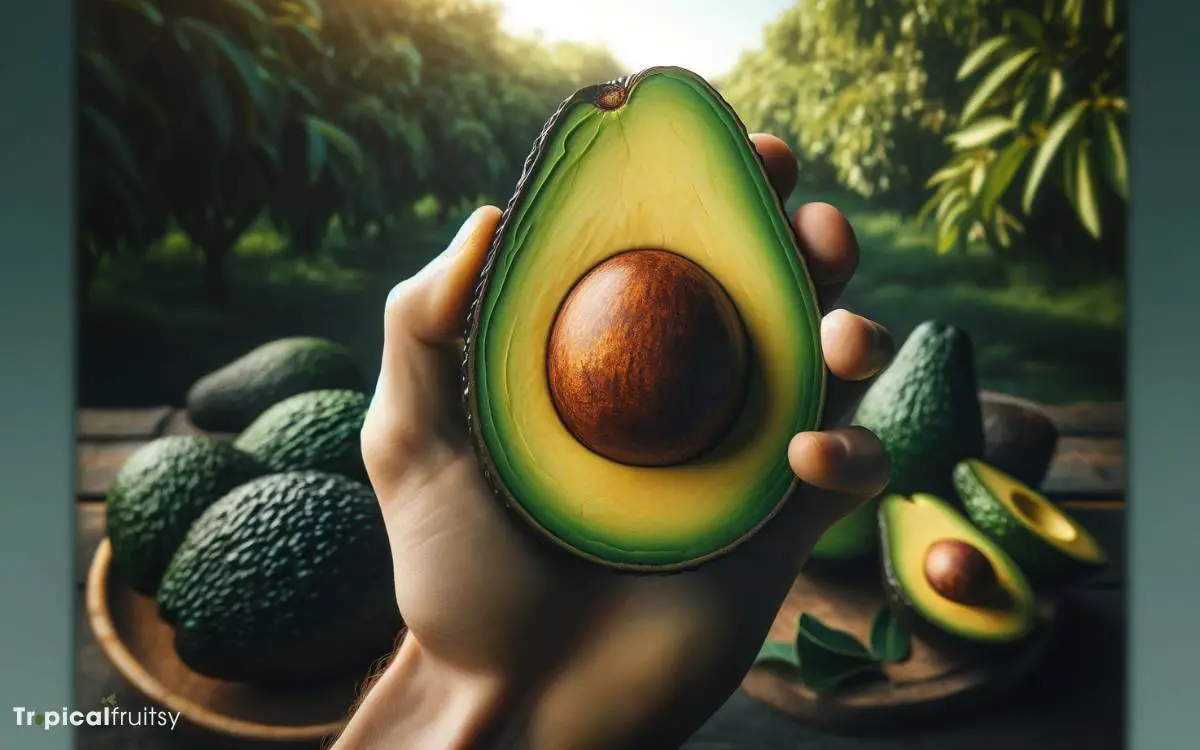
Although the avocado is widely appreciated for its creamy flesh, it is equally notable for its large, central seed, which plays a crucial role in the plant’s reproductive cycle.
Constituting approximately 18% to 20% of the fruit’s weight, the seed is encased within a durable, brown seed coat, protecting the embryonic plant within.
From a botanical perspective, this seed is a critical agent of propagation, ensuring the continuation of the Persea americana species.
The seed contains high concentrations of nutrients, including fatty acids, proteins, and phytochemicals, which support the initial growth phase of a new avocado plant.
Additionally, the large size of the avocado seed is an evolutionary adaptation that favors dispersal by large mammals, a factor that once was critical for the species’ proliferation in the wild.
Mango: The Juicy Stone
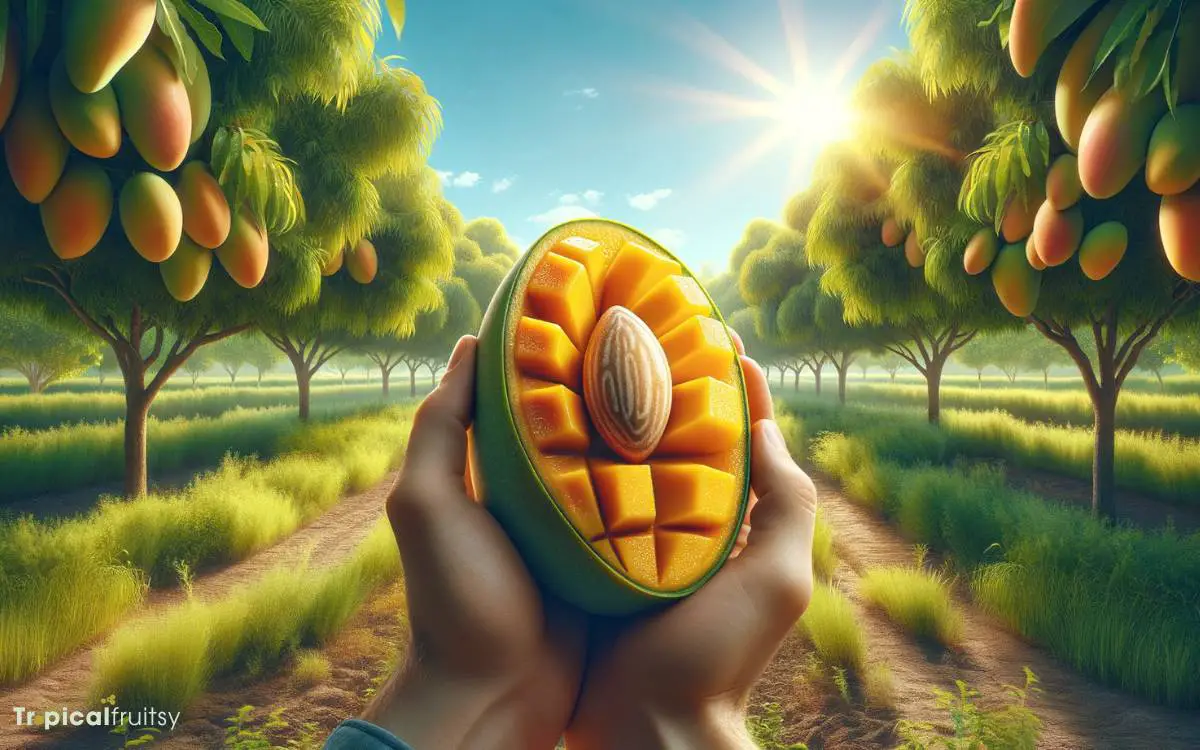
The mango, a drupe or stone fruit, is characterized by a sizable ovule-encased seed central to its structure, surrounded by juicy, edible flesh.
Examination of the seed reveals potential uses not only in propagation but also in traditional medicine and as a source of oil or butter, reflecting its multifunctional value.
the diversity within stone fruit varieties, including the mango, underscores the importance of understanding specific cultivar traits for optimized culinary application and consumer satisfaction.
Mango Seed Uses
Within the succulent flesh of the mango lies a large seed that, beyond its role in reproduction, has various applications in culinary, medicinal, and cosmetic fields.
The kernel within this seed is rich in various compounds that have been meticulously analyzed for their beneficial properties.
Through a process of extraction and refinement, the mango seed yields substances that are integral to a myriad of products and applications.
- Culinary Utilization: Mango seed kernels can be processed into a flour substitute for gluten-free cooking, offering a high-fiber alternative with a subtle flavor profile.
- Medicinal Attributes: Extracts from the mango seed demonstrate antioxidant and antimicrobial properties, potentially contributing to cardiovascular health and metabolic regulation.
- Cosmetic Enhancement: Oils derived from mango seeds are incorporated into skincare products for their moisturizing and regenerative effects on the dermis.
These uses underscore the multifaceted value of the mango seed, underscoring the importance of comprehensive utilization of tropical fruit byproducts.
Stone Fruit Varieties
Building upon the diverse applications of the mango seed, it is pertinent to note that the mango is a prime example of a stone fruit, characterized by its large and fibrous endocarp encasing the seed.
The definition of stone fruits, or drupes, encompasses a spectrum of fruits with a similar morphology, wherein a fleshy exocarp, or skin, and a succulent mesocarp, or flesh, surrounds a hardened endocarp with a seed inside.
Botanically, Mangifera indica conforms to this classification, differing from other stone fruits such as peaches and cherries primarily in size and fibrous texture.
Analytically, the mango’s classification informs agricultural practices, consumer expectations, and culinary applications.
Notably, the mango’s substantial seed size has implications for propagation and genetic conservation, underscoring its significance in both horticulture and biodiversity.
Culinary Applications
Branching out from its horticultural importance, the mango’s versatile flavor profile and succulent flesh lend themselves to a myriad of culinary applications ranging from sweet to savory dishes.
The fruit’s high pectin content makes it an excellent candidate for jams, jellies, and preserves, while its tropical essence enhances the sensory appeal of various culinary creations.
- Reduction and Glazes: Mango puree can be reduced to form a glaze for meats, adding a sweet-tangy flavor that complements the richness of the protein.
- Desserts and Pastries: Incorporated into desserts, mango adds a refreshing note to cakes, tarts, and mousses.
- Salsas and Chutneys: Diced mango contributes to salsas and chutneys, offering a complex interplay of sweetness and acidity that pairs well with grilled seafood or poultry.
As we explore the culinary versatility of tropical fruits, we segue into the unique aspect of papaya—its edible seeds.
Papaya’s Edible Seeds
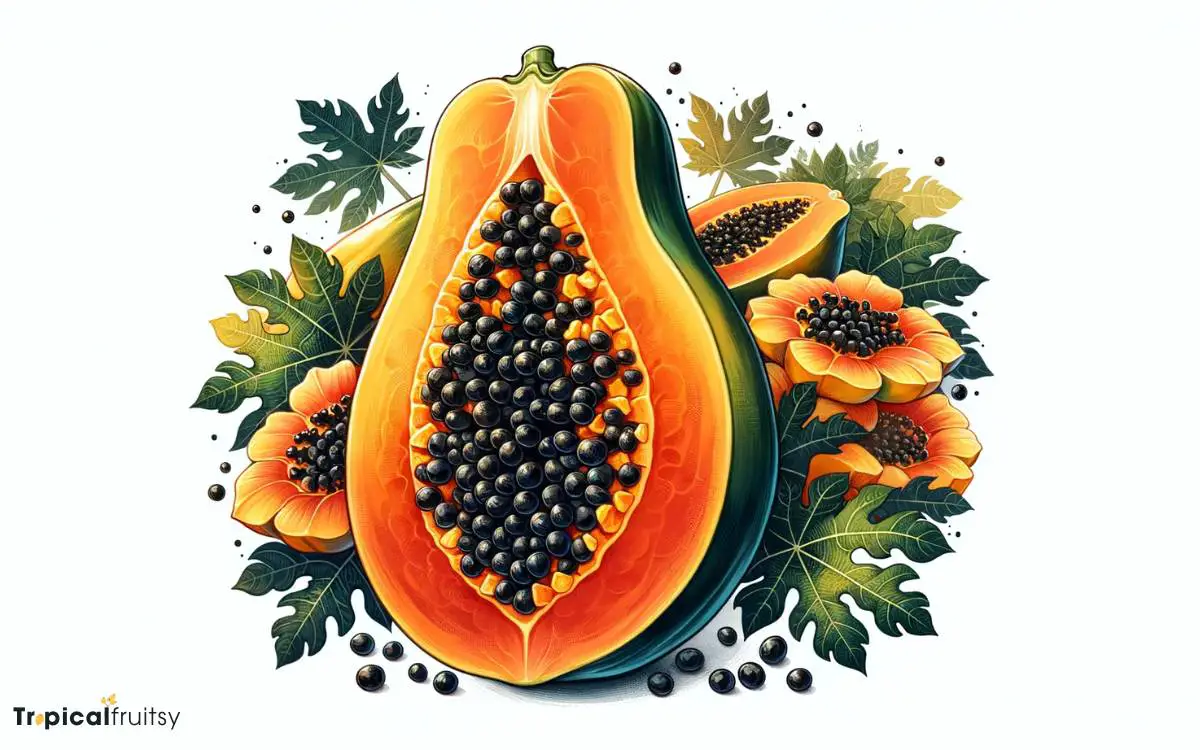
The papaya’s central cavity contains numerous small, black, edible seeds that are often compared in flavor to black pepper or mustard. These seeds are encased in a gelatinous substance that enables their dispersion.
Scientific analysis indicates that the seeds have potential health benefits, including antibacterial properties and the ability to aid in digestion due to the presence of the enzyme papain.
| Nutrient | Content in Papaya Seeds |
|---|---|
| Proteolytic Enzymes | Aid digestion |
| Alkaloids | Possess antibacterial properties |
| Monounsaturated Fatty Acids | Benefit heart health |
| Dietary Fiber | Supports gastrointestinal regularity |
The bioactive compounds present in papaya seeds, such as carpaine, benzyl isothiocyanate, and glucosinolates, contribute to their medicinal qualities.
These attributes warrant further research to quantify their therapeutic potential. Moving forward, we shift our focus to the unique sapote pit, another tropical fruit seed with distinctive characteristics.
The Unique Sapote Pit

Transitioning from the multifaceted papaya seeds, we now examine the sapote pit, a large, singular seed that resides at the heart of its fruit, renowned for its creamy texture and sweet flavor.
The sapote pit, which can be likened to an avocado stone in size and shape, presents a distinctive set of characteristics that differentiate it from other tropical fruit seeds:
- Size and Shape: The sapote pit typically exhibits an oval or elliptical form, with a size that can be substantial relative to the fruit’s overall volume.
- Seed Coat: A robust, woody endocarp encases the seed, providing protection and aiding in the dispersal process through animal consumption.
- Germination Potential: The sapote seed demonstrates a high germination rate under optimal conditions, contributing to the species’ propagation.
In an analytical context, the sapote pit’s morphology and germinative properties are critical in understanding the reproductive strategies of tropical fruit species.
Cherimoya’s Seedy Center
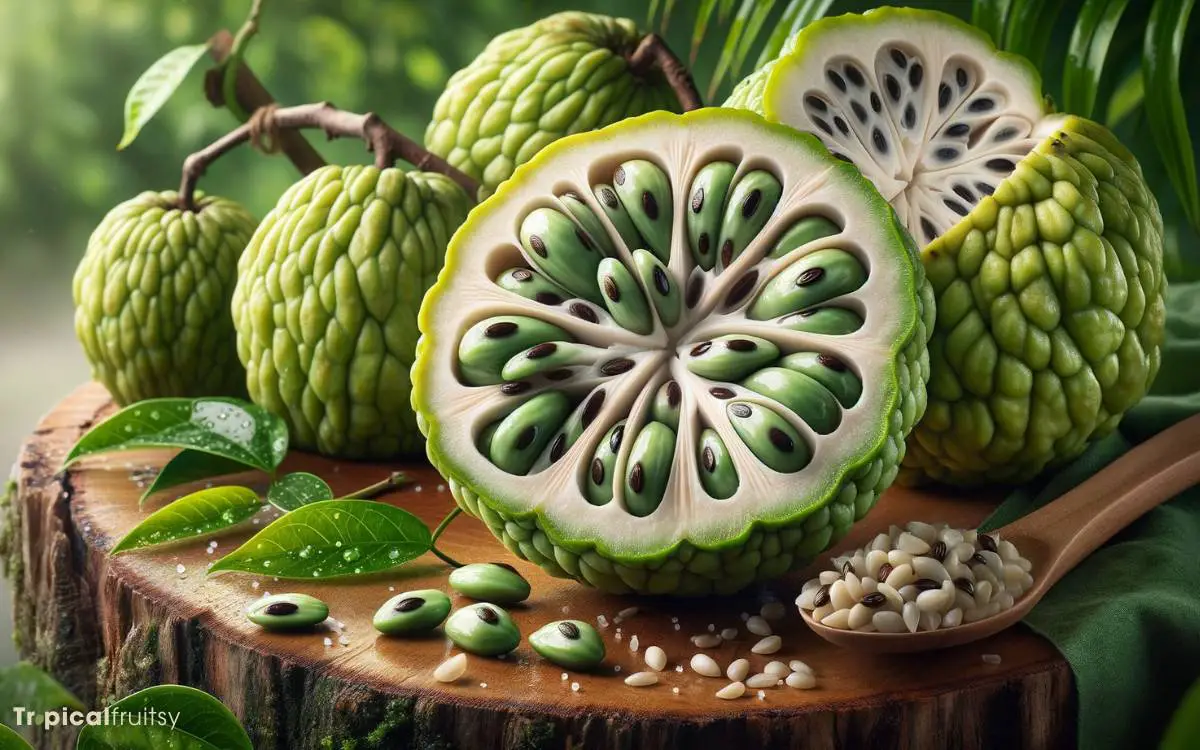
Delving into the heart of the cherimoya, one discovers multiple large, brown seeds embedded within its fragrant, custard-like flesh, each playing a crucial role in the propagation of this tropical delicacy.
These seeds are recalcitrant, meaning they do not withstand drying and therefore must remain moist to remain viable.
Their size, often comparable to that of a large bean, is an evolutionary trait favoring dispersal by megafauna.
Botanically, these seeds are classified as endospermic, with a storage tissue providing essential nutrients for the embryonic plant during germination.
The seeds’ hard coating protects the embryonic plant from mechanical damage and predation, while their chemical composition deters consumption by unsuitable dispersal agents.
As we meticulously examine the properties of cherimoya seeds, our attention is drawn to another enigmatic component of tropical fruits: the mysterious mamey seed.
The Mysterious Mamey Seed

A single large seed, encased within the succulent flesh of the mamey sapote, distinguishes this tropical fruit and intrigues botanists with its unique characteristics.
The mamey seed’s attributes are noteworthy for several reasons:
- Size and Shape: Typically oval or ellipsoid, the seed can grow up to 5 inches in length, making it a significant botanical specimen.
- Germination Process: Mamey seeds exhibit a hypogeal germination, where the cotyledons remain below the soil surface, a trait not commonly observed among large-seeded tropical fruits.
- Chemical Composition: The seed contains various compounds, including saponins and alkaloids, which have sparked interest for potential pharmaceutical applications.
With its singular presence, the mamey seed offers a fascinating contrast to the next subject of discussion: the jackfruit’s massive seeds, which similarly dominate the interior of another tropical giant.
Jackfruit’s Massive Seeds
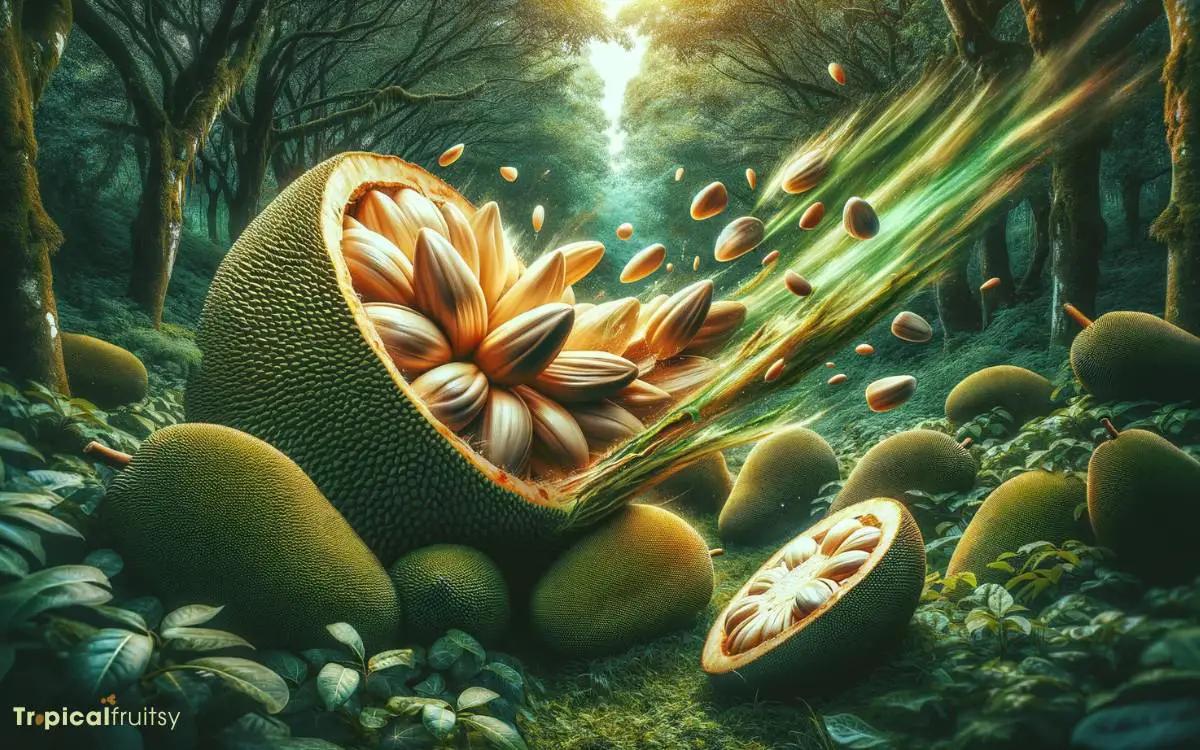
Moving on to the jackfruit, it is noteworthy for harboring seeds of considerable size that are not merely vestigial but possess notable culinary versatility.
An analysis of seed culinary uses reveals that jackfruit seeds can be roasted, ground, or incorporated into various dishes, providing nutritional benefits alongside flavor.
Furthermore, understanding the germination process of these large seeds is essential for propagation and cultivation, impacting agricultural practices and food production.
Seed Culinary Uses
Within the realm of culinary applications, the large seeds of the jackfruit are often boiled, roasted, or integrated into various dishes as a nutritious ingredient.
These seeds are not only rich in protein but also contain significant amounts of potassium, calcium, and iron, contributing to their value in a balanced diet. Their starchy texture and subtle flavor make them versatile for culinary innovation.
- Boiling: Seeds are typically boiled until tender, making them easier to peel and then consumed directly or mashed into dishes.
- Roasting: Seeds can be oven-roasted to develop a nutty flavor, often used as a snack or ground into flour.
- Integration: Cooked seeds are incorporated into curries, stews, or used as a meat substitute, providing texture and nutritional benefits.
Germination Process
The germination process for jackfruit seeds, which are among the largest of any tropical fruit, begins with the absorption of water through the seed coat.
This initial stage, known as imbibition, results in the seed swelling and the activation of metabolic processes within the embryo.
Following imbibition, the radicle emerges, penetrating the soil to anchor the seedling and absorb nutrients and moisture.
Concurrently, enzymatic actions convert stored food within the endosperm into usable sugars, supplying energy for the growth of the seedling.
As the shoot apex ascends, photosynthesis commences, transitioning the seedling from heterotrophic to autotrophic nutrition.
This complex series of events is highly sensitive to environmental conditions, such as temperature, moisture, and light, which must be optimal to ensure successful germination and establishment of the jackfruit seedling.
Does the Tropical Fruit with a Big Seed in the Middle Have Any Relation to Drift Seeds and Fruits?
Yes, tropical drift seeds and fruits have a relationship with the large-seeded fruit found in tropical regions. These large seeds are often designed to float and are carried by ocean currents, allowing them to spread and colonize new areas. It’s a fascinating example of nature’s intricate interconnectedness.
Durian: A Spiky Surprise

Although known for its pungent aroma, the durian fruit is equally notable for its large seed encased within a formidable, spiky husk.
This tropical fruit, native to Southeast Asia, is often called the ‘king of fruits’ due to its size, unique flavor, and nutritional profile.
The large seed within the durian is a key reproductive component, and despite its size, it is not consumed due to its hardness and potential toxicity.
Analyzing the durian from a botanical perspective reveals several noteworthy characteristics:
- Seed Size: The durian seed is typically 2 to 5 centimeters in length, a considerable size relative to the overall fruit volume.
- Husk Properties: The external rind is covered with hard, sharp spines that protect the fruit from natural predators.
- Aroma Compounds: Durian’s potent smell is attributed to a combination of volatile sulfur compounds, which serve to attract certain pollinators while repelling others.
Conclusion
Tropical fruits such as avocados, mangoes, papayas, sapotes, cherimoyas, mamey, jackfruit, and durian are characterized by the presence of prominent seeds.
The seeds serve as a vital reproductive feature, reflecting an evolutionarily crafted strategy for species propagation.
Their size and structure are pivotal for the survival of the respective species, ensuring their continuation in the lush, competitive ecosystems where they thrive. The seeds’ imposing presence is a testament to nature’s ingenuity.


